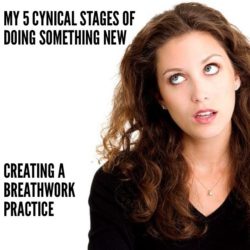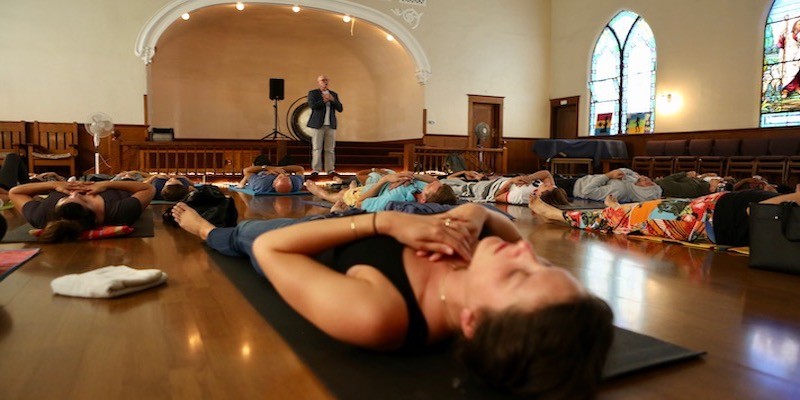We All Have Breath Control
Have you ever wondered why we can control our breathing at will? It might not seem like much of a superpower when you don’t know how to use this ability, but it’s actually a powerful gift many people never tap into.
Your breath gives you control over your state of mind and your body’s chemistry. Breathing gives you access to parts of yourself and your physiology that most people never realize is possible.
Breathwork is a transformational practice you can use to overcome trauma, reach your full potential, and live a happier, healthier life.
If you’re reading this, maybe you’ve already tried some form of breathwork and explored different techniques. If so, you’ve already begun your journey..
Maybe you’ve never attempted breathwork before but you’ve heard about it. Perhaps you have questions about breathwork and how you might benefit from the practice.
You’ve come to the right place.
I’ve put together this comprehensive, no-BS guide on breathwork so you can better understand why the practice of breathwork is so transformational for so many people.
Read on and I’ll try to explain the unexplainable.
What Is Breathwork?
“Breathwork” is an umbrella term for various types of conscious and controlled breathing practices that have the power to improve your physical, mental, and emotional wellbeing.
Many people who teach breathwork have tried to trademark or brand the practice, but this adds confusion in my opinion. Names you’ll hear include “Transformational Breathwork”, “Clarity Breathwork”, or “Shamanic Breathwork”; the list goes on. The truth is, all breathwork is a modern form of pranayama, a practice with a long history on the Indian subcontinent. In pranayama, the breath is used as a tool to calm the mind, regulate the body’s energy, and improve physical and mental well-being.
As breathwork has gained popularity in recent years, scientists have been studying the practice as a form of alternative therapy for treating physical, mental, and emotional issues.
Even if you’re new to the practice, you’ve probably done breathwork before. You just didn’t think of it as breathwork. For example, have you ever taken deep breaths to calm your nervous system? This is an example of basic breathwork.
Breath-centered practices and meditations can be found in many ancient cultures and traditions, including Taoism, Buddhism, Hinduism, Christianity, Yoga, Qigong, Shamanism, Sufism, and martial arts. Many of these traditions use breathing techniques for reasons similar to modern breathwork: to alter consciousness for spiritual purposes, self-discovery, or healing. There are hundreds or even thousands of types of breathwork (e.g., transformational breathwork, clarity breathwork, and shamanic breathwork).
Breathwork isn’t one single technique, but a range of practices that each have different effects on the body-mind. Some examples are slow and deep breathing, alternate nostril breathing, and even holding one’s breath for short periods of time.
The technique I teach is called “circular breathwork” – also known as connected breathing. It’s a specific type of breathwork that involves breathing through the mouth in a circular pattern.
Keep reading to explore how circular breathwork functions, the benefits of circular breathwork, and the science behind it.
Is Breathwork Hyperventilation?
Before you begin this practice, let’s make one thing clear: breathwork is NOT hyperventilating. I’ve heard people suggest this before, but it’s inevitably someone who has never actually done breathwork.
Hyperventilating is when you exhale more oxygen than you’re taking, which can lead to a change in carbon dioxide levels in the bloodstream. The symptoms of hyperventilating are lightheadedness, dizziness, chest pain, and even fainting. This is obviously not something we want to achieve through conscious breathing.
With breathwork we actually try to take in as much oxygen as we can. It’s a deliberate and intentional practice that is used to influence your body’s chemistry and achieve certain physical benefits, such as increased energy and reduced stress, as well as mental benefits such as increased focus and reduced anxiety.
There have been several studies that indicate breathwork is the opposite of hyperventilation and that the two practices have different physiological effects.
Deep breathing techniques used in breathwork practices can decrease anxiety as well as increase feelings of calmness and relaxation. Conversely, hyperventilation has been associated with increased stress and anxiety.
Additionally, breathwork practices can improve respiratory function, increase oxygen saturation levels, and reduce stress and anxiety. By contrast, hyperventilation is linked to decreased oxygen saturation levels as well as increased anxiety and stress.
Here’s what most people don’t realize: the rate of breathing is what separates breathwork from hyperventilation.
The latter involves breathing at a rapid pace that creates a chemical imbalance in the blood. Breathwork involves slower and more controlled breathing. It is a deliberate and intentional practice with tangible physical and mental benefits.
One more thing to keep in mind: more advanced breathwork techniques like circular breathing should be performed under the guidance of an experienced teacher, at least the first few times. This is especially true if you have pre-existing medical conditions.
As a veteran breathwork instructor, I can guide you through the process safely and effectively, until it becomes easier for you to integrate breathwork practice into your daily life.
How Does Breathwork Transform The Body And Mind?
When you do breathwork, you control and use your breath to affect your physical, mental, and emotional body. This allows you to tap into different states of consciousness and into the body’s natural healing abilities.
Here’s what happens to your body during controlled breathing:
- Your cells receive a higher amount of oxygen, which can help reduce symptoms of stress and anxiety.
- Your nervous system responds to the breathwork by activating the relaxation response and reducing feelings of stress and anxiety. Studies show that breathwork gives you the ability to tap into your parasympathetic nervous system. These practices can reduce symptoms of stress and anxiety.
- Your brain produces more alpha waves, which are associated with feelings of calm and relaxation.
- You think less and tap into your intuition with the help of transient hypofrontality. This is a temporary reduction in activity in the frontal regions of the brain, which are associated with higher-level cognitive processes such as attention, decision-making, and self-awareness.
- Your ego dissolves by reducing activity in certain areas of the brain. One of the areas that has less activity is the frontal cortex a.k.a. the “default mode network.” The DMN is a network of brain regions that is highly active when the brain is at rest and not engaged in any specific task. It has been associated with a number of cognitive processes, including self-referential thinking, mind-wandering, and the sense of self. By reducing activity in the DMN, breathwork may be able to promote a temporary state of “ego-dissolution” in which the sense of self is diminished and the individual is less likely to be attached to their thoughts and feelings.
Controlled breathing practices, such as circular breathwork, can regulate the nervous system, release emotions, reduce stress, and improve physical health.
In simple terms, breathwork can quiet your inner critic, calm the monkey mind, balance your mood, and promote a deep sense of inner peace.
What Is Circular Breathwork?
A Transformational Type Of Breathwork To Change Your Stress Response
Circular breathwork is a type of connected breathing that involves breathing in and out through the mouth in a circular pattern. This type of breathing works to unify the breath and create a connection between the physical, mental, and emotional bodies.
It has been shown to have numerous benefits for physical and mental well-being by stimulating the body’s natural healing mechanisms.
The circular pattern of breathing creates a rhythmic and cyclical movement of oxygen and energy throughout the body. This increased flow of oxygen and energy can help to promote physical and emotional healing by activating the parasympathetic nervous system and leading to a release of built-up tension and stress. Circular breathwork can also increase the levels of endorphins, the body’s natural painkillers, which can help to reduce pain and promote well-being.
Controlled breathing can significantly increase endorphin levels and improve overall feelings of well-being, reduce stress, and improve mood.
What Is Circular Breathing Technique?
After reading all that, you’re probably curious about the circular breathing technique I teach and what it feels like exactly. The science is there to support the benefits, but what does it actually feel like?
Here’s what you can expect from a breathwork session with me: The circular breathwork technique I teach is performed lying down on your back in a comfortable position. It’s best to keep your back straight so you can inhale deeply. Do not use a pillow under your head unless you really need it, as this can obstruct the throat and make it difficult to breathe into your belly.
We begin breathing, which involves three phases. I explain everything in detail during class, but the gist of it is this: two breaths in, one breath out.
The first breath goes into the belly. The second breath in your chest. Then you let it go without pushing the air out.
During the session with me, music plays in the background to help motivate, relax, and help you release anything that’s stuck. I’ll guide you through the process.
Focusing on doing the technique correctly is important the first few times, or you risk doing it wrong and hyperventilating instead. This is why you need me to guide you as you get accustomed to this type of breathwork. If you correct your mistakes early on, you will very quickly develop a correct, safe, and effective technique.
Of course, you don’t want to obsess over getting everything perfect either. When you notice critical thoughts coming in, just know that it’s your mind resisting transformation.
After 10-15 minutes of circular breathing, the breath starts to guide you. That’s when you may have some life-changing experiences. By the end of the session, you are left feeling full of love, gratitude, joy, and peace.
Circular breathwork is powerful and profound, but it can feel a bit challenging in the beginning. Hopefully, you’ve done harder things than laying on the floor breathing! If so, you’ll be just fine and do a great job.
As with anything you do to heal, there might be some resistance. But if you push through the barriers and resistance ONCE, my breathwork technique will break you out of your same old cycle and clear out stress, anxiety, anger, depression, and just about any other unwanted negative emotion.
You will know it’s working the first time you do it because how you’ll feel afterwards is undeniable. My students often say one session feels like 20 years of therapy!
Is Circular Breathing Safe?
In over a decade of leading thousands of people through breathwork, I’ve never once seen anything bad happen. My technique is done lying down on your back. NEVER driving, NEVER in water. Why? Because breathwork really powerful, and it can create an altered state.
Here’s the best thing about it: you’re IN CONTROL. We’re not in the jungle, doing ayahuasca and puking into a bucket. If you feel that it’s too intense for you, you can ALWAYS tone it down a notch, breathe through your nose and resume the technique when you’re comfortable.
You can get off the ride at any time. You’re totally in control, AND you can do it in the middle of a Tuesday afternoon when you’re having a bad day, as I have for many years.
Breathwork isn’t any more dangerous than riding a bicycle or going to the gym. The difference is no one is really that fearful of the gym because we all know what it is at this point. We only fear the unknown.
What Will You Experience During A Breathwork Session?
Breathwork is an amazing experience, but there can also be some discomfort as your body gets used to it. Please bear in mind that it’s called breathWORK for a reason!
During a circular breathwork session, you might get some of these symptoms (most people get freaked out the first time they get them, but I can assure you these are completely normal and harmless):
- A tingly sensation in your hands, feet, and face
- Dizziness, light-headedness
- Muscle tightness in the hands and jaw. This is called “tetany” and mostly happens to beginners and people who have a calcium, magnesium, or iron deficiency. It’s not dangerous and goes away once you resume normal breathing.
- Altered states and intense emotional release
If you do experience these symptoms, you have two options:
- Push through the discomfort. This is hard to do when your mind is full of resistance, but it’s also very rewarding, because you get all the benefits and also build resilience. Just tell yourself “Shut up and breathe” until your mind lets go of fear/panic. This is what I did every time during the first five years of practicing breathwork.
- Slow down your breathing and rebalance. As I said before, you are in control. You can always pace yourself during this practice. Take a deep slow breath through your nose and exhale slowly until you feel ready to start circular breathing again.
Are There Contraindications For Doing Circular Breathwork?
Like most types of therapy, breathwork isn’t appropriate for everyone. It’s recommended that you consult with your healthcare provider (including any mental health provider), and also let me, your teacher, know about any health concerns before participating in a breathwork session.
Breathwork can result in an intense physical and emotional release. Therefore, it is not advised for persons with a history of cardiovascular disease, including angina or heart attack, high blood pressure, glaucoma, retinal detachment, osteoporosis, any significant recent physical injuries or surgeries.
Breathwork is not advised for persons with severe mental illness or seizure disorders or for persons using major medications. It is also unsuitable for anyone with a personal or family history of aneurysms.
Pregnant women are advised against practicing breathwork without first consulting and getting approval from their primary care physician.
Persons with asthma should bring their inhaler and consult with their primary care physician and the breathwork facilitator before their first session.
Here are the common contraindications for breathwork:
- Cardiovascular problems
- High or abnormal blood pressure
- History of aneurysms
- Epilepsy or history of seizures
- Anyone on heavy medication
- Severe psychiatric symptoms, particularly psychosis or paranoia
- Bipolar depression
- Osteoporosis
- Recent surgery
- Glaucoma
- Pregnancy
- An active addiction
- Any person with mental illness who isn’t in treatment or lacks adequate support
Additionally, those who have experienced recent trauma or are in a highly emotional or sensitive state may not be appropriate candidates for breathwork.
Breathwork sessions can sometimes bring up intense emotions and memories, which can be overwhelming and difficult to process without proper support. Make sure you are ready to face the difficult feelings that may come up and that you have a solid support network to help you process these feelings after the session is over.
Some people may feel uncomfortable or even experience anxiety while participating in breathwork, especially if they have a fear of losing control or losing consciousness.
My role as your teacher is to guide you and support you through this. During my breathwork sessions I motivate you to let go of your fears and push through the discomfort.
What Are The Benefits of Circular Breathing?
Circular breathwork is hard work, but it also pays off tenfold. The physical benefits of doing this kind of breathing alone are worth integrating it into your wellness routine. According to studies, circular breathing has the following benefits for your overall health:
- Massive stress relief and deep relaxation: Circular breathing has been shown to activate the parasympathetic nervous system, which is responsible for promoting relaxation and reducing stress.
- Improves mood, and reduces anxiety and depression: Circular breathing has been shown to increase levels of endorphins, the body’s natural feel-good chemicals, which can help to improve mood and overall well-being.
- Enhances breathing function and immune function: Circular breathing has been shown to have a positive impact on the immune system by increasing the flow of oxygen and energy throughout the body.
- Relief from physical pain: Circular breathing has been shown to increase levels of endorphins, which can help reduce pain and promote well-being.
- Improves sleep and increases energy levels: Circular breathing has been shown to help regulate the body’s sleep-wake cycle and improve sleep quality.
Bear in mind, these are just the physical benefits of circular breathwork. In my experience (as well as in the experience of thousands of others), that’s barely scratching the surface. There’s also a long list of spiritual and mental benefits that science isn’t currently researching but are just as important. Circular breathwork can results in a variety of benefits:
- Emotional regulation
- Manifesting greater abundance
- Deep healing of wounds, grief, and traumas
- Access to expanded states of consciousness, including higher guidance and clarity
- Transcendence of the mind and emotions; awakening to the truth of who you really are
- Mystical revelations
- Greater self-love and more loving relationships
- Increased connection to source
- Overwhelming feelings of joy
- Deep inner peace
- Feelings of connectedness and oneness
These are all experiences myself and my students have had during and after doing breathwork.
You have so much to gain from this practice, whether you seek health benefits, spiritual benefits, or both!
How Do You Prepare For A Breathwork Session?
Breathwork is something you can easily do anytime you feel like you need to rebalance yourself. You don’t need to prepare a lot, but here are a few things to keep in mind to make the most of each session:
- Choose a quiet and comfortable room, away from kids, pets, and other distractions. This is YOU time, so make sure you create the right environment to support the experience.
- Wear comfortable clothes that aren’t too tight and keep you warm. Loose-fitting clothes are the best. During breathwork, your body temperature might change, so make sure you also keep a blanket nearby.
- Avoid heavy meals before the breathwork session. Better yet, do it on an empty stomach. If you have food in your stomach you might experience discomfort that makes it hard to take deep breaths.
- Drink water. Make sure you hydrate before your session to support the rapid breathing required in circular breathwork. You also don’t want to interrupt your session because you feel thirsty or dehydrated.
- Keep an open mind. Come to the session with an open mind and a willingness to explore the experience. Don’t be hard on yourself if you find it difficult to get into the rhythm at first. With practice, your technique will improve. Plus, I will be there to guide and support you all the way through.
Why Do My Classes Focus On Circular Breathwork Technique?
When I first discovered the circular breathwork technique, it blew me away. I couldn’t believe that I had this power inside of me to clear out all my stress anxiety anger and depression in one session – and no one had ever told me about it before.
When my brain finally returned a normal state, my first thoughts were: Why doesn’t the whole world know about this? Why didn’t somebody show this to me when I was a teenager, and I was doing drugs and feeling suicidal?
After I learned this technique I decided to go and explore all the other breathwork techniques as well. I went down this wild New Age, woo woo rabbit hole, and tried so many different techniques and methods. But nothing compared to the original technique I did.
Still so much of it didn’t resonate with me. I didn’t care for the music the teacher used. I didn’t feel like the teachers of it were preparing people properly for all of the intense emotions and physical sensations that could come during breathwork. I didn’t feel like they said enough to keep me moving and motivated during the difficult challenges at the beginning stages of breathing.
I really wanted to experience something powerful after the breathwork session. That’s why I created the class I offer now.
I essentially took the technique and developed an entirely new style around circular breathwork. I lead the class that I want to take myself. It’s a much more modernized and relatable style.
And most importantly after it clears out all your stress, anxiety, anger and “stuff”: a breathwork session leaves you filled with gratitude and love.
I know that sounds like a pretty monumental and hard-to-believe experience in just one class, but like I always tell people: Try it and tell me that I’m wrong.
Is Breathwork For You?
The short answer is YES.
If you don’t have any major health issues and are willing to put some work into your transformation, breathwork is definitely for you.
We all live busy lives. We all have different degrees of unresolved trauma. We all deserve to love ourselves more and live a purposeful life, instead of merely existing.
Breathwork is the only quick fix I know for inner healing. One session and you’ll know exactly what I mean. Don’t worry, even if you’re skeptical like I was, you will feel different afterwards. The results are undeniable from the first session.
When Is A Good Time To Begin Practicing Breathwork?
Now. Don’t overthink it. It doesn’t matter where you’re at or what’s going on in your life, now is the best time to start.
Breathwork is different for everybody and different every time. I know this sounds like a lot, but don’t take my word for it. Try it and find out for yourself.




